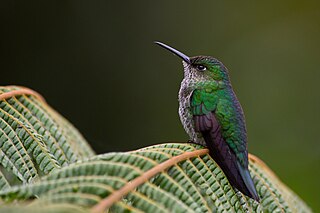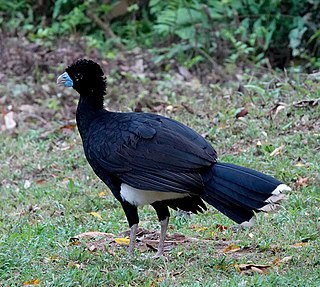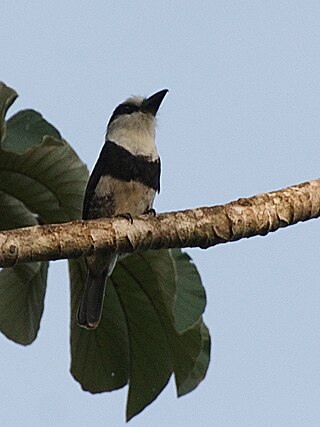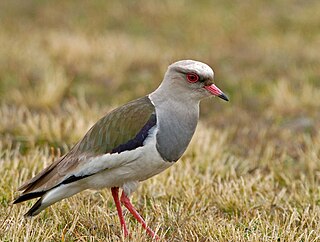
The white-bellied woodstar is a species of hummingbird in tribe Mellisugini of subfamily Trochilinae, the "bee hummingbirds". It is found in Bolivia, Colombia, Ecuador, and Peru.

The many-spotted hummingbird is a species of hummingbird in the "emeralds", tribe Trochilini of subfamily Trochilinae. It is found in Bolivia, Colombia, Ecuador, Peru, and possibly Argentina.

The sickle-winged guan is a species of bird in the chachalaca, guan, and curassow family Cracidae. It is found in Bolivia, Colombia, Ecuador, and Peru.

The blue-billed curassow is a species of bird in the family Cracidae, the chachalacas, guans, and curassows. It is endemic to Colombia.

The crestless curassow is a species of bird in the family Cracidae, the chachalacas, guans, and curassows. It is found in Brazil, Colombia, Guyana, and Venezuela.

The razor-billed curassow is a species of bird in the family Cracidae, the chachalacas, guans, and curassows. It is found in Bolivia, Brazil, Colombia, and Peru.

The nocturnal curassow is a species of bird in the family Cracidae, the chachalacas, guans, and curassows. It is found in Brazil, Colombia, Ecuador, Peru, and Venezuela.

The rufous-headed chachalaca is a species of bird in the family Cracidae, the chachalacas, guans, and curassows. It is found in Colombia, Ecuador, and Peru.

The speckled chachalaca is a species of bird in the family Cracidae, the chachalacas, guans, and curassows. It is found in Bolivia, Brazil, Colombia, Ecuador, and Peru.

The chestnut-capped puffbird is a species of bird in the family Bucconidae, the puffbirds, nunlets, and nunbirds. It is found in Bolivia, Brazil, Colombia, Ecuador, Peru, and Venezuela.

The moustached puffbird is a species of near-passerine bird in the family Bucconidae, the puffbirds, nunlets, and nunbirds. It is one of seven species in the genus Malacoptila. It is found in Colombia, Ecuador, and Venezuela.

The brown nunlet is a species of near-passerine bird in the family Bucconidae, the puffbirds, nunlets, and nunbirds. It is found in Colombia, Ecuador, and Peru.

The white-necked puffbird is a species of bird in the family Bucconidae, the puffbirds, nunlets, and nunbirds. It is found in Mexico, Central America, Bolivia, Brazil, Colombia, Ecuador, Peru, and Venezuela.

The blackish nightjar is a species of bird in the family Caprimulgidae. It is found in Brazil, Bolivia, Colombia, Ecuador, French Guiana, Guyana, Peru, Suriname, and Venezuela.

The Andean lapwing is a species of bird in family Charadriidae, the plovers and their relatives. It is found in Argentina, Bolivia, Chile, Colombia, Ecuador, and Peru.

The grey-capped cuckoo is a species of bird in the tribe Phaenicophaeini, subfamily Cuculinae of the cuckoo family Cuculidae. It is found in Colombia, Ecuador, Peru, and Venezuela, as a vagrant on Bonaire and in the Galápagos Islands, and possibly in Panama.

The pallid dove is a species of bird in the family Columbidae. It is found in Colombia, Ecuador, and Peru.

The white-throated crake is a species of bird in subfamily Rallinae of family Rallidae, the rails, gallinules, and coots. It is found in Colombia, Costa Rica, Ecuador, Honduras, Nicaragua, Panama, and Venezuela.

The chestnut-tipped toucanet is a near-passerine bird in the toucan family Ramphastidae. It is found in Bolivia, Colombia, Ecuador, and Peru.

The white-throated daggerbill, white-throated wedgebill, or western wedge-billed hummingbird is a species of hummingbird in the family Trochilidae. It is found in Colombia and Ecuador.























